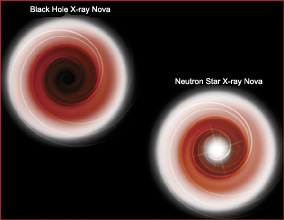January 11, 2001
CXC PR: 01-03
SAN DIEGO -- Astronomers have used NASA's Chandra X-ray Observatory to study some of the darkest black holes yet observed. Their work strongly confirms the reality of the "event horizon," the one-way membrane around black holes predicted by Einstein's theory of relativity.
The findings were presented today at the American Astronomical Society meeting by Drs. Michael Garcia, Jeffrey McClintock, Ramesh Narayan, and Stephen Murray of the Harvard-Smithsonian Center for Astrophysics and Dr. Paul Callanan of University College, Cork, Ireland.
With results that fundamentally differ from earlier black hole studies, Garcia and his colleagues have shown that some recently discovered black holes are not only ultra-dense, but actually possess event horizons that "vacuum up" energy from their surroundings.
"It is a bit odd to say we've discovered something by seeing almost nothing at all -- less than the smile of the Cheshire cat, so to speak," said Garcia, lead author on a paper submitted to the Astrophysical Journal, "but, in essence, this is what we have done."
Using data from Chandra and previous X-ray satellites like ROSAT, the Chandra team studied a dozen "X-ray novas," so named because they occasionally erupt as brilliant X-ray sources then settle into decades of dormancy. The great outpouring of X rays is due to a stream of gas that is pulled from the surface of a Sun-like companion star onto a compact object, either a black hole or a neutron star.
By comparing the energy output from the dormant X-ray novas, the team discovered that the sources with black holes emitted only one percent as much energy while dormant as did the X-ray novae with neutron stars.
"The most straightforward explanation of these observations is that the black hole candidates we have studied have event horizons that swallow just about all of the energy that surrounds them," said Murray. "Indeed, one could even say that this work shows why black holes deserve to be called ‘black.’"
"The event horizon is the defining characteristic of a black hole, but obviously it is very difficult to detect since any infalling material at the event horizon is observable for only an instant as it plunges inward at the speed of light," said McClintock. "The comparison of black holes and their close cousins, the neutron stars, may be the most promising way to get a handle on the event horizon."
If the collapsed star is a neutron star with a solid surface, energy must be released when infalling matter strikes that surface. In contrast, if the accreting object is a black hole, there is no surface for the matter to strike. Instead, both the energy and the matter will be lost from view forever once they cross the event horizon. A small amount of energy can escape just before the matter crosses the event horizon, but the scientists believe that it should be much less than the energy released by matter hitting a neutron star surface.
"Watching matter flowing into a black hole is like sitting upstream of a waterfall and watching the water seemingly vanish over the edge," said Narayan, chairman of the Harvard Astronomy Department. "However, if the waterfall were replaced by a dam -- the analog of a neutron star surface -- then the water would pile up and one would see a mighty lake".
Why are dormant black hole sources a hundred times fainter than the neutron star sources? The amount of material falling towards the collapsed star and the subsequent energy release are believed to be nearly the same, whether the compact object is a black hole or a neutron star. Therefore, the remarkable difference in brightness comes, according to the team, because of the event horizon, where the inward pull of gravity becomes infinitely strong. This is in contrast to the situation of neutron stars that have a more normal surface.
By observing the motion of the companion star in an X-ray nova, the mass of the collapsed star can be estimated. In some cases, this mass is more than three times that of the Sun. Over that limit, gravitational forces would crush a neutron star or any compact object into a black hole, according to Einstein’s relativity theory. This provides a crucial test for identifying black holes.
"It is difficult to appreciate the astounding sensitivity of Chandra to X rays," said Callanan. "For the faintest black hole we detected, Chandra measured literally a handful of photons."
The researchers used the Advanced CCD Imaging Spectrometer (ACIS) on the Chandra X-ray Observatory for exposure times varying roughly from 10,000 to 40,000 seconds per object.
The ACIS X-ray camera was developed for NASA by Pennsylvania State University and MIT. NASA's Marshall Space Flight Center in Huntsville, AL, manages the Chandra program. TRW, Inc., Redondo Beach, California, is the prime contractor for the spacecraft. The Smithsonian's Chandra X-ray Center controls science and flight operations from Cambridge, MA.
This work was supported by funds from NASA and NSF.
During the AAS meeting, the scientists involved in this release can be reached at the AAS Press Room at the Town & Country Resort in San Diego, CA. The phone numbers for the Press Room are (619) 908-5057, (619) 908-5040, and (619) 908-5041 from January 8-11.
Images associated with this release are available on the World Wide Web at:
MEDIA CONTACTS
Dolores Beasley
NASA HQ
Phone: 202-358-1753
Steve Roy
Marshall Space Flight Center, Huntsville, AL
Phone: 256-544-6535
Megan Watzke
Chandra X-ray Observatory Center, CfA, Cambridge, MA
Phone: 617-496-7998



